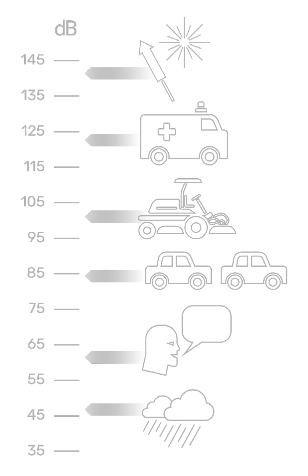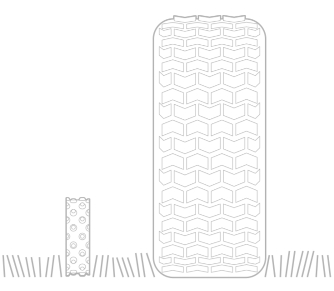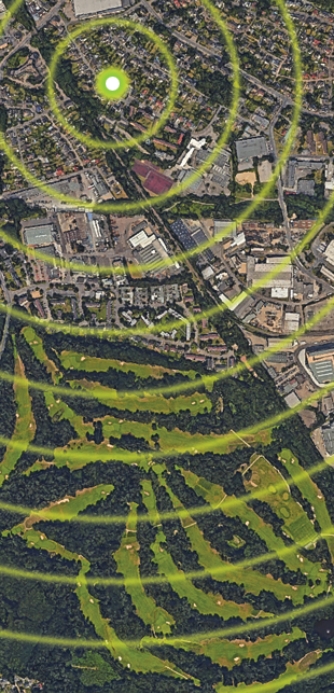Some of the world’s most iconic golf courses are shifting to unmanned mowing
Find out how Kress is redefining turf maintenance worldwide.
Free your staff for what matters more
Stop assigning your skilled landscapers to endless hours of mowing. Let Kress Robotics handle the routine, so your team can focus on perfecting every detail of your course.
Find a dealer near youLet the roar be from the crowd, not the mowers
Kress robotic mowers glide across the turf like a drained putt, ensuring your golfers remain focused on the game, fully immersed in the experience.
The sound of silenceQuieter greens, better games

Diesel-powered commercial mowers are typically as loud as 105 dB. Kress robot mowers are around 60 dB. But don’t jump to conclusions: this doesn’t mean they are simply 40% quieter than diesel mowers.
Decibels (dB) are a logarithmic unit of measurement for sound intensity, which means that each increase of 3 dB represents a two-fold increase in noise pressure.
To put it into perspective, a 105 dB noise is 32,768 times more intense in terms of sound pressure than the 60 dB noise from a Kress robotic mower. While 60 dB is comparable to the sound of a normal conversation, 105 dB is akin to standing next to a busy highway or even louder.
For golf courses that value tranquillity, this difference is monumental. A quieter course means less disturbance for golfers, allowing them to focus on their game and enjoy the serene environment that is essential to the golfing experience.
No matter the weather
Rain or shine, Kress robotic mowers are engineered to ensure superior traction even in wet or cold conditions, where massive tractor tires would slip.
Explore the physics behind itPhysics behind the traction

In automotive sports, it’s well-known that on slippery surfaces like snow or mud, narrower tires provide better traction. Let’s see why, and if the same applies to turf maintenance.
Friction, the force that allows movement, depends on two main factors: the coefficient of friction between the surfaces (in this case, the tire and the ground) and the perpendicular force, which is the weight of the machine. Ton-heavy machines require greater friction to move effectively because they exert more perpendicular force. They also need broad tires not to dig grooves into the turf. That’s fine on solid surfaces, but on slippery surfaces, wide tires tend to float, losing the ability to maintain sufficient contact and generate the required friction.
Lighter machines like Kress robotic mowers require much less friction to move. Their narrow tires focus the weight into a smaller contact area, ensuring they “bite” into the surface, providing reliable traction. This precise balance of weight and traction in Kress mowers ensures that your turf remains pristine, even in challenging conditions.
Don’t let your signature turf crack under pressure
Heavy machinery compacts the soil, cutting off essential air and water supply to the roots, resulting in expensive turf renovation. At only 25 kilos, Kress robotic mowers won’t crack your turf.
Nerd it outDon’t press too hard

When heavy machinery is used to mow grass, the weight of the machine compacts the soil, reducing the amount of space between soil particles. Soil compaction makes it more difficult for air, water, and nutrients to penetrate the soil, which leads to a number of negative effects:
Reduced root growth and development due to poor soil aeration and drainage
Increased risk of turf diseases and pest infestations due to stress and reduced vigour
Poor water infiltration and drainage, which can lead to standing water and surface runoff
Reduced turf density and coverage, which can impact the playability and aesthetics of the course
Increased maintenance requirements and costs to address soil compaction and other turf issues
Weighting a fraction of any tractor, a Kress RTKn robotic lawn mowers will substantially improve the quality of the course. They also extend the lifespan of the turf and reduce the need for frequent, expensive, and disruptive renovation.
Maximise your ROI with smart turf management
Stop the high upfront costs, fuel and maintenance expenses of traditional mowers. With minimal energy usage, Kress delivers significant savings, superior turf quality and a better allocation of your skilled staff.
Nothing is better
Other RTK mowers need multiple antennas across your golf course, which not only adds to your costs but also disrupts the scenic beauty. Kress ensures centimetre-level accuracy with no need for additional infrastructure.
Explore the edgeOur network

RTK, or Real-Time Kinematic, is a cutting-edge geo-positioning technique that improves the precision of satellite data. It works by comparing the data a moving object receives from satellites with the coordinates of a fixed antenna.
Unlike competitor RTK mowers that require on-site correction antennas, Kress RTKn (with the “n” symbolising network power) utilises an exclusive network of antennas, each covering an area of up to 60 km in radius.
The Kress network’s widespread coverage includes your golf course, of course.
Master of complexity
Broad and heavy robotic mowers can handle open areas, but what about the tricky semi-roughs, slopes, and tight corners? With Kress, every inch of your course gets the attention it deserves.
Explore the rangeYour course, your rules
Other robotic mowers force you to reshape your course to fit their limitations. Kress respects your course’s natural contours, preserving the integrity and beauty of your landscape.
Find a dealer near youTwo-holes-in-one
Switch to Kress mowing to reduce your carbon footprint and boost your environmental reputation. A win for your course, and the planet.
We’re growing our dealer network.
Leave your email, and we’ll let you know when a Kress dealer opens near you.
